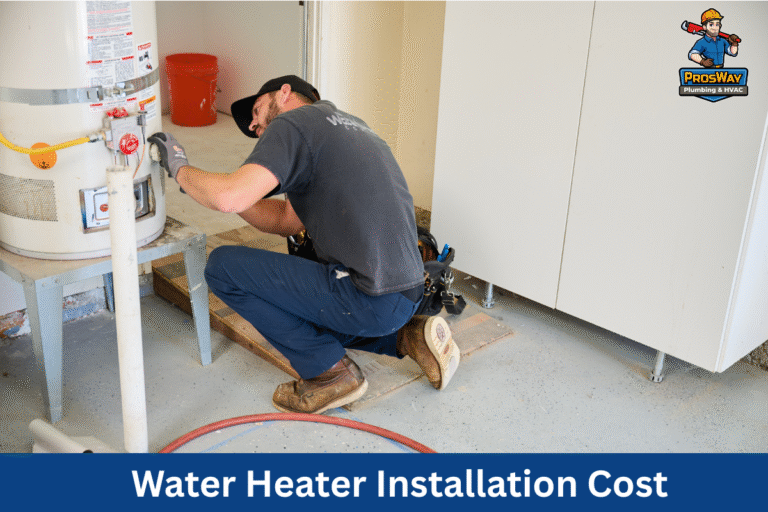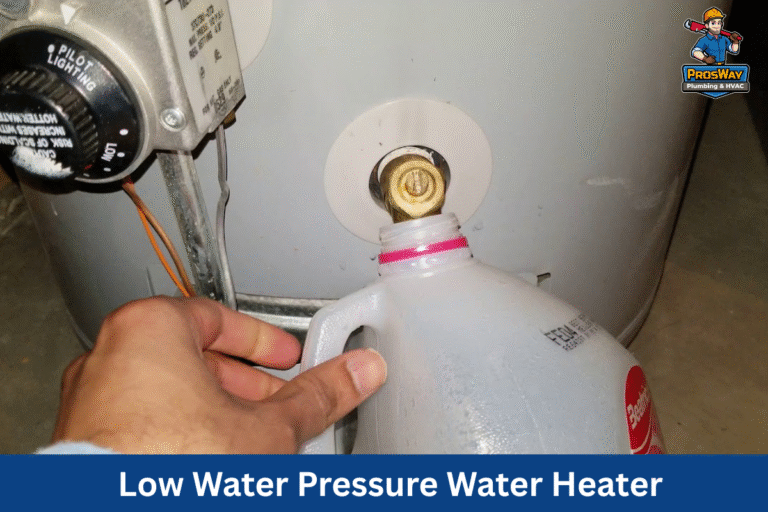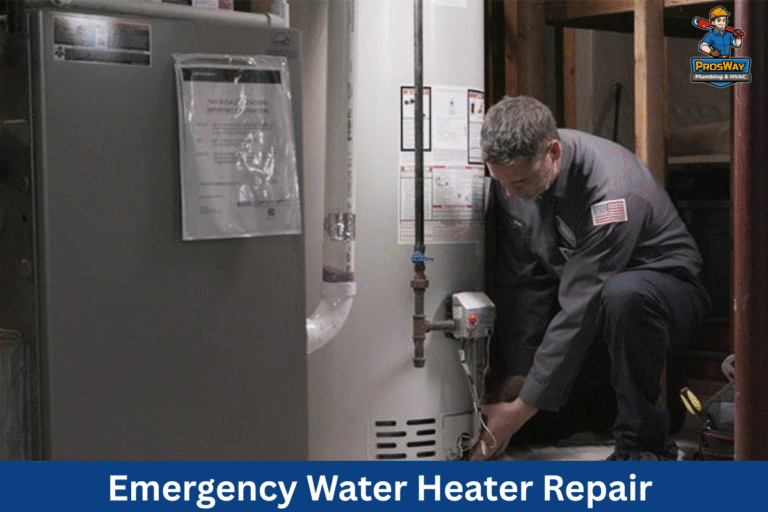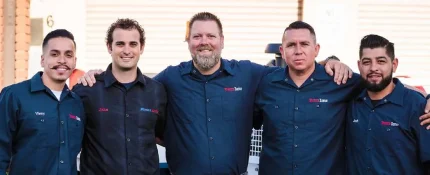Today’s blog breaks down the costs associated with sewer line inspections and explains why they are an essential step in preventing plumbing disasters. At ProsWay Plumbing & HVAC, we’re committed to helping Parsippany-area residents avoid plumbing issues by providing reliable inspections.
Cost in a Nutshell
The average costs for residential sewer line inspections can vary significantly based on several factors. Commercial inspections typically carry different price points due to their size and complexity.
Typical Residential Range
The typical cost for residential sewer line inspections typically ranges between $125 – $500. This price often includes the analysis of sewer lines as part of a home inspection, particularly in properties with a septic tank system.
Homeowners should be aware that the cost can increase if additional issues are discovered, such as sewer gas leaks or blockages caused by tree roots, which may require drain clearing or rooter services for resolution.
That said, purchasing a warranty for plumbing services may help offset some inspection costs. A comprehensive home inspection that includes sewer line evaluation can provide peace of mind for property owners.
Typical Commercial Range
Price variations for commercial sewer line inspections can differ significantly from residential ones due to different factors.
For instance, large commercial buildings often have extensive sewer lines that require more in-depth evaluation through sewer camera inspections.
These inspections provide essential knowledge about the system’s health and accessibility issues.
Typically, commercial sewer camera inspections range from ≈approximately $299 to $399, depending on the specific requirements of the property.
The cost can increase if additional services, like repairing blockages or addressing structural concerns, are needed.
What Is a Sewer Line Inspection?
A sewer line inspection is a professional, non-invasive diagnostic of your home plumbing system’s main drain line, typically done using a high-definition sewer camera. This process helps detect hidden problems inside the wastewater system before they turn into expensive emergencies.
The sewer line is the large pipe that carries waste from your house to the city’s main sewer or your septic system. It runs underground, so you can’t visually check it—unless you use a camera.
What Does it Find?
Here’s what sewer inspections help identify:
- Pipe blockages caused by grease buildup, hygiene products, or debris
- Tree root intrusion, a major cause of cracked pipes in older properties
- Pipe corrosion in metal pipes, like cast iron or galvanized steel
- Offset joints or bellied pipes where wastewater pools
- Early signs of sewer backup that may not yet affect your drains
Even newer homes can have sewer issues. Construction debris or improper pipe slope during build-out can cause drainage failures. This isn’t just about age, it’s about what’s hiding underground.
How Pros Do It?

The inspection is done using a sewer scope—a small, waterproof camera attached to a flexible cable. It’s pushed through the line either manually or with robotic help, depending on the pipe’s size and length.
Step-by-step process:
- Locate the access point—usually the cleanout pipe, floor drain, or sometimes a roof vent.
- Insert the camera carefully, watching the feed in real-time on a monitor.
- Push through the drain line, scanning every foot for cracks, roots, or signs of wear.
- Note distance markers—so problem areas can be located and fixed without guessing.
- Use an electronic locator above ground to match the camera’s position underground.
- Record the inspection—often saved as a video file or provided as a report with screenshots.
Licensed plumbers or certified sewer inspectors handle this with professional tools and training. They don’t just find issues—they interpret what they mean and what actions are needed.
Camera Types and Resolution
Not all cameras are created equal. The quality of the footage affects what you can see—and what you might miss.
Types of Sewer Inspection Cameras:
- Standard Definition (SD): Basic clarity, suitable for large obstructions, but may miss early-stage corrosion or hairline cracks.
- High Definition (HD): Crystal-clear images that catch subtle damage. This is ideal for preventative maintenance and verifying pipe integrity before a remodel or home purchase.
- Self-Leveling Cameras: Automatically keep the image upright so you’re not watching footage upside down. This helps when reviewing the video or understanding what’s going on in real-time.
- Push Rod vs. Crawler-Mounted
- Push Rod: Flexible, manually guided. Good for residential lines.
- Crawler: Motorized, steerable. Best for commercial buildings or longer, larger pipes.
- Push Rod: Flexible, manually guided. Good for residential lines.
Some companies also offer:
- Video file delivery (USB, cloud link)
- Annotated reports with timestamps and repair recommendations
- Voiceover documentation during the live feed
Locators, Crawlers, and Safety Gear
An inspection isn’t just about shoving a camera down a pipe. Professional sewer inspections often include:
- Electronic Pipe Locators: These detect the position and depth of the camera head underground. That means no guessing where a blockage or break is—essential if excavation or trenchless repair is needed.
- Crawlers (Mini Robots): Used mostly in commercial jobs or large-diameter pipes, they provide more control and visibility. They’re equipped with HD cameras and sometimes even lighting or lasers for pipe measurement.
- Hydro Jetting Equipment (On Standby): A hydro jet may be used first to clear the way if the camera can’t get past a blockage. This uses high-pressure water (up to 4,000 PSI) to cut through roots, grease, or sludge.
- Safety Gear: Sewer inspections can expose technicians to bacteria and gases like methane. Pros use:
- Nitrile gloves
- Eye protection
- Respirators (in high-risk jobs)
- Protective suits (in contaminated systems)
- Nitrile gloves
Why this matters: These aren’t just flashy tools—they help protect your home, save time, and avoid misdiagnoses that could lead to unnecessary pipe replacement costs.
Cost Breakdown
When you get a sewer line inspection, you’re not just paying for someone to run a camera through a pipe. There’s more going on behind the scenes—gear, labor, diagnostics, and in some cases, extra services.
Let’s break it down.
Labor makes up the bulk of the cost, usually 60% to 70%. You’re paying for:
- The inspector’s time (setup, inspection, breakdown, and reporting)
- Skill level—licensed plumbers or certified sewer inspectors charge more
- Travel time, especially in rural or hard-to-reach areas
- Risk—working with wastewater involves exposure to contaminants and potential hazards
Equipment makes up the other 30% to 40%.
- Sewer cameras range from $1k and above $15k, depending on resolution and features
- Locators, lighting, and crawlers add thousands more
- Maintenance, battery swaps, and video storage also factor in
So if you’re quoted $300 for a standard sewer camera inspection, around $200 is likely going to labor, and $100 covers the use of the gear.
Add-Ons (Hydro-Jetting, Dye Tests, Video File)
Some inspections start at a flat rate but increase if add-ons are needed. These extras can help you get more value, but they do cost more.
1. Hydro Jetting
The plumber might offer hydro jetting to clear it if the line is too clogged to inspect.
- Cost: $150–$600+ (depending on pipe length and severity)
- Use case: Thick grease, roots, or sludge blocking the path
Note: Some companies bundle hydro jetting with inspection at a discount.
2. Dye Testing
A fluorescent dye is flushed through your fixtures to trace leaks or illegal connections in the system. Helpful for spotting cross-contamination between drain lines or identifying storm drain infiltration.
- Cost: $75–$250
- Often used in: Real estate sales, city compliance checks.
3. Video File or Written Report
Not all companies include this in the base price.
- Digital video file: $25–$50
- Written summary report: $50–$100
- Full inspection package (video + report + locator map): $100–$150
You’ll likely want these documents if you’re using the inspection as part of a home sale or remodeling permit.
Tip: Ask if the report includes timestamped footage, repair notes, and severity grading.
Price Drivers
Several price drivers influence the cost of sewer line inspection. The pipe length, depth, material, region, permits, and after-hours calls, system complexity play significant roles in determining expenses.
At ProsWay Plumbing & HVAC, we want to ensure you’re informed and prepared before investing in this critical plumbing service.
Pipe Length, Depth, and Material
The length of the sewer line significantly impacts sewer inspection costs. Longer sewer lines often require more time and resources to inspect, whether using a sewer camera inspection or a borescope.
As the distance increases, so do labor charges, leading to higher overall expenses for the homeowner.
Depth matters too.
- Pipes buried 3–4 feet are common.
- But some homes, especially those with basements or on hillsides, have lines 8+ feet deep.
Greater depth may require advanced locating tools and increase the need for add-ons like video mapping or multiple access points.
Pipe material also affects difficulty:
- PVC or ABS: Smooth and easy to inspect
- Clay or cast iron: More prone to cracks, corrosion, and debris
- Orangeburg (old fiber pipes): Often collapsing, messy to inspect
Region, Permits, and After-Hours Calls
Cost variations for sewer line inspections depend significantly on location. Typically, urban areas experience higher sewer line inspection costs compared to rural locations.
The increased demand for services in densely populated regions often results in elevated labor rates. Home buyers in these areas should anticipate that inspections may include advanced techniques.
In contrast, rural areas may offer lower sewer line inspection rates due to reduced demand and easier access to sewer systems.
Inspectors often face fewer challenges with accessibility, minimizing labor and equipment costs. For home buyers in rural settings, this could mean more affordable options for addressing potential issues.
Permits
Local regulatory and permit fees can significantly affect the sewer line inspection cost for homeowners. Many municipalities require permits for sewer work, which can lead to additional expenses on top of the camera plumbing inspection cost.
An awareness of these fees is crucial for homeowners, as they can vary widely depending on local regulations.
In urban areas, the cost of permits often increases due to higher demand for services and stricter regulations aimed at managing debris.
Homeowners should be aware that these fees can contribute significantly to the total expense of a sewer line inspection.
System Complexity
The complexity and size of a sewer line system significantly affect the cost of a sewer scope inspection.
Larger systems with multiple bends or extensive lengths require more time and specialized equipment for thorough inspections.
For home buyers, understanding the condition of a property’s sewer line can be crucial, especially if the system is intricate.
Real estate agents often advise clients to schedule a sewer line inspection to avoid unexpected expenses.
Hidden Costs & Extras

Homeowners must consider several additional expenses when planning for sewer line inspection costs. Pre-cleaning needs, follow-up sewer line repairs or relining, and warranty or service-plan changes can contribute to overall costs and provide peace of mind.
Pre-Cleaning Needs
Expenses related to Pre-cleaning needs can significantly affect sewer line inspection costs. Homeowners may need to clear access points by removing obstacles that obstruct the inspection site.
This preparation ensures inspectors can effectively evaluate the sewer line without incurring additional labor charges due to accessibility issues.
Identifying visible signs of leaks or clogs can help clarify the issues beforehand, giving the inspector a better understanding.
Follow-Up Repairs or Relining
Follow-up services and repairs can substantially influence the overall cost of sewer line inspections.
After an initial inspection reveals problems, homeowners need immediate repairs or relining to resolve these issues quickly.
These repairs could range from minor fixes to significant overhauls and often require additional inspections.
Also, you should consider the potential for unexpected repairs after a sewer line inspection service.
Warranty or Service-Plan Charges
Some companies offer service plans or warranties on their inspection work. These can be helpful—but they’re not always free. Warranty or guarantee fees can add to the overall cost of sewer line inspections, providing homeowners with peace of mind.
Many plumbing companies offer warranties on their work, which can protect homeowners from potential future issues related to the repairs.
They can vary significantly between service providers and may influence the final pricing of the sewer inspection.
Opting for a service that includes warranty or guarantee fees may lead to a higher initial cost.
Is It Worth It?
Let’s get to the real question: Is a sewer line inspection actually worth the money? Short answer—yes. And here’s why it often pays for itself many times over.
Inspection vs Average Repair Bill
Let’s compare some numbers.
| Service | Average Cost |
| Sewer line inspection | $200–$500 |
| Spot repair (small section) | $350–$3,000 |
| Full replacement | $2,000_$20,000+ |
| Emergency excavation | $5,000–$25,000 |
For the cost of a few hundred bucks, you can:
- Detect early pipe corrosion before collapse
- Spot tree root intrusion before it ruptures the line
- Find blockages before they cause a sewer backup in your home
A simple camera check could save you thousands in emergency repair costs, not to mention the mess and property damage that comes with backups.
Impact on Resale Value
A sewer inspection is one of the smartest moves you can make if you’re buying or selling a home.
For buyers:
- You avoid inheriting a failing drain line
- You get leverage in negotiations if damage is found
- You understand what kind of system you’re buying (clay, cast iron, PVC)
For sellers:
- It builds buyer trust
- It can speed up escrow by avoiding inspection surprises
- You might even command a higher offer if everything checks out
In some cities (e.g., parts of California and Pennsylvania), a sewer lateral inspection is even required before selling.
Case Study: Root Catch Saves $8k
A homeowner in Portland, OR, scheduled a $325 sewer camera inspection before listing their home. The camera found a minor root intrusion near a joint, about 18 feet from the cleanout.
They had it snaked and treated with root-killing foam for $200. Two months later, the buyer’s inspector praised the clean line and clear documentation. The sale closed without issue.
Estimated savings?
Without that inspection, roots would have eventually broken the joint. Repair quote later revealed it would’ve cost $8,400 to dig and replace.
That’s the power of preventative maintenance—and a few hundred bucks well spent.
Picking the Right Inspector
When evaluating different sewer line inspectors, it is vital to consider certain factors to make informed decisions about the appropriate service for your needs.
Licensing, Insurance, and Gear Quality
Always ask these questions before hiring:
1. Are you licensed and insured?
- A licensed plumber or certified sewer inspector will know local codes and how to spot serious issues.
- Insurance protects you if something goes wrong, like damage to the cleanout or property.
Red flag: If they dodge this question or offer only verbal confirmation, move on.
2. What kind of camera equipment do you use?
- Look for HD cameras, self-leveling models, and locators.
- Ask if they provide a video file, not just a verbal explanation.
3. Do you offer a written report?
- Especially important for real estate inspection purposes
- The report should include:
- Pipe material
- Observed defects
- Estimated pipe length
- Footage timestamps or distances
- Recommendations for repair (if needed)
- Pipe material
Sample Report Checklist
Here’s what a good inspection report should include:
- Pipe location and depth (using locator tools)
- Noted issues: blockages, root intrusion, corrosion, etc.
- Pipe material: PVC, cast iron, clay, etc.
- Video or photo evidence (screenshots with labels or time stamps)
- Severity grading: minor, moderate, or urgent
- Repair suggestions: if any problems are found
You’re not getting what you paid for if the inspector just tells you “It looks fine,” and doesn’t show proof.
Reading Reviews the Right Way
Customer reviews and testimonials are invaluable resources when assessing various sewer line inspection service providers.
They provide insights into the quality and reliability of the services offered, helping property owners make informed decisions.
By reading about the experiences of others, you gain a sense of the company’s overall value concerning costs.
Additionally, positive testimonials can indicate a service provider’s proficiency in handling sewer inspection complexities.
Engaging with customer feedback both highlights strengths and uncovers possible weaknesses in service.
Budget & Timing Tips

Setting a realistic budget for sewer line inspections involves understanding various costs, timing, and potential long-term expenses.
Therefore, compare quotes from different service providers to find the best value while ensuring quality.
Identifying costs that may arise from necessary repairs or upgrades can help in budgeting effectively.
How Often to Inspect?
Routine monitoring through sewer camera inspections is critical to maintaining system efficiency. These inspections can be integrated into your annual or bi-annual maintenance routine, helping detect changes in pipe condition.
This proactive approach prevents surprise breakdowns and offers peace of mind, especially in older properties in Northern New Jersey, where aging systems are common.
Bundle with Pre-Sale or Remodel Checks
One of the best times to inspect your home plumbing system is before a major remodel or when preparing to sell your home. In case you’re planning to add a bathroom, finish a basement, or renovate a kitchen, an inspection gives you a clear picture of whether your existing system can handle the load.
For sellers, including a sewer scope inspection with your pre-sale documentation can prevent negotiation issues later. It shows buyers that your system is in good condition or gives them clarity on repairs already completed. In competitive markets, this kind of transparency builds trust and can speed up the closing process.
DIY Warning Signs Before You Call
You don’t always need to wait for a disaster to schedule an inspection. Certain warning signs can help you know when it’s time to call a licensed plumber.
Watch for:
- Slow drains, especially if it’s happening in more than one fixture
- Gurgling toilets, which can signal a blockage or venting problem
- Bad smells coming from floor drains or unused sinks
- Water backing up after laundry or heavy rain
These symptoms suggest something is off deeper in the drain line—something a camera can reveal clearly. Don’t rely on guesswork or store-bought solutions. And avoid using a cheap snake camera; these DIY tools often lack the reach and video quality needed to diagnose real problems.
Myths & FAQs
Being aware of common misconceptions about sewer line inspection costs is crucial for homeowners. Myths about pricing can obscure the actual value of services, leading to poor decisions.
Only Old Homes Need This
This one comes up a lot. Yes, older homes with clay or cast iron lines are more likely to have issues like corrosion, root intrusion, or collapse. But newer homes aren’t immune.
In fact, inspectors often find construction debris, poor pipe slope, or damaged PVC lines in homes built within the last 10 years. One common problem? Workers flush leftover materials or even paper towels into the line during final construction cleanup. These blockages don’t show up right away, but they can cause problems within a year or two.
No matter how new the house is, a sewer scope gives peace of mind and helps catch hidden issues early.
Insurance Covers Every Break
This is a dangerous assumption. Most standard homeowner insurance policies do not cover damage to the main sewer line, especially if the pipe is located outside your home’s foundation. Damage caused by wear and tear, root growth, or corrosion is usually considered “maintenance-related,” not accidental.
Some insurers offer sewer line endorsements or add-on policies, but they often have limits and exclusions. These might cover trenchless repair or partial replacement, but only if you have the coverage before the damage occurs.
That’s why inspections are important. A small upfront cost can prevent a big uncovered bill later.
How Long Does the Visit Take?
A typical residential sewer inspection takes 30 to 60 minutes. This includes setup, camera insertion, recording, and review of findings with the homeowner.
It could take up to 90 minutes if the pipe is long, has multiple bends, or requires clearing. Commercial inspections usually take longer due to more complex layouts and pipe lengths.
You don’t usually need to be home the entire time, but it helps to be there during the review portion, so you can see the footage and ask questions directly.
FAQs
1. Does homeowner’s insurance pay for a sewer line inspection?
No, it usually doesn’t. Sewer inspections are considered routine maintenance, and insurance only covers sudden, accidental damage, not preventive checks.
2. Is the video recording included in the quoted price, or an extra fee?
Some plumbers include the video file in the base price, but many charge an extra $25–$100. Always confirm if it’s part of the quote before booking.
3. How much more will the inspection cost if the technician must hydro-jet first?
Hydro-jetting may be needed before inspection if the line is blocked. This typically adds $200–$600 to your total, depending on pipe length and buildup.
Yes, emergency or after-hours inspections usually cost 1.5 to 2 times more. It covers overtime, travel, and priority scheduling during peak demand.
5. Can I save money by bundling the inspection with other plumbing services?
Yes. Many companies offer discounts when you bundle a sewer inspection with services like drain cleaning, leak detection, or pre-sale plumbing checks.
Key Takeaways
- Sewer inspections are essential preventive maintenance—they catch problems early, before they become expensive.
- Detects hidden issues like pipe blockages, tree root intrusion, pipe corrosion, and early signs of sewer line failure
- Non-invasive: Uses high-resolution cameras and locators—no digging required.
- Typical cost: $200–$500 for residential inspections and extras (hydro jetting, video reports) may raise the price.
- Way cheaper than repairs: Full pipe replacement or sewer backup cleanup can cost $5,000–$15,000+.
- Ideal timing: Before a remodel, before selling or buying a home, when you see slow drains or gurgling sounds
- Boosts resale value and prevents inspection surprises during a home sale.
- Choose a licensed, well-reviewed plumber with professional gear and reporting tools.
- Don’t rely on myths—even new homes and insured properties can have costly hidden issues.
- Schedule a sewer line inspection now, if it’s been years (or never).









